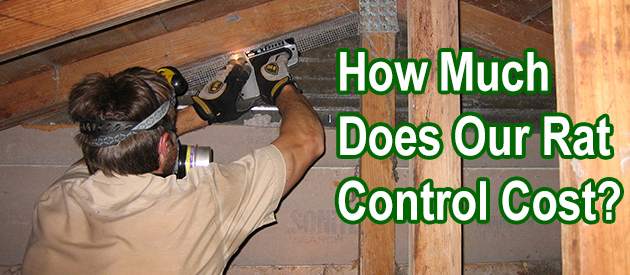Jackson County, Kansas City Rat Control Situation:
My mother has a medium size varment running around and we have put snap traps out only for it to get away with the peanut butter. waste of good peanut butter! The strange thing is it's eating the philadrium plant taking leaves off. not touching lucky bamboo in water ot the amarilys bad spelling. can you tell me why? Anyway, I've got a dozen traps baited with peanut butter on the obvious trails up there. My question is: should I put traps on top of the insulation (I've got loose blown insulation), on the joists (which aren't quite wide enough), move the insulation out of the way between the joists and put the trap on the ceiling drywall, or something else? I kind of did a mix for this first run, and I guess I'll figure it out eventually through trial and error, but I'd welcome any advice and any other tips would be greatly appericated. gail
I read the articles on your web site. Back in August, I had a new roof, soffit, eavesthrough done. Everything appears fine, the company did a great job, no complaints. About 2 weeks ago, we stated to hear scratching noises in the attic between 2 - 4 am. The noises are in the light to medium range, it does not seems to be a large animal such as a racoon. So, I have no idea what is up there, but I obviously have to deal with it. I walked around the house and up on the roof to see if I could find any entrances. I could not find any. Would you have any idea on what animal would be up there at this time of year. I live in Ontario Canada, about 30 miles west of Toronto. I'm going to start with setting mouse traps. Any advice/suggestions would be helpful.
Kansas City Rat Control Tip of The Week
The Myth That Poison Makes Rats Thirsty And Die Outside
No, rat poison doesn't make the rat thirsty. Poison doesn't make the rodent go out to drink, and along these lines die outside. Rat poison makes the rat dormant, and it dies any place it happens to be at when the poison takes effect. Since the rats living inside a house or building invest most of their energy inside the structure, they usually die inside that building, not outside.
Will Poison Make A Rat Thirsty And Die? (NO - That's A Myth)
Individuals use poisons since they think it is a protected, viable, hands-off strategy for evacuating pests. They have certain thoughts regarding it, but what amounts of those thoughts are true? One thought many convey is that poison will make rodents thirsty. When they consume the poison, they will out of nowhere have a solid, insatiable thirst. That will lead them outside, looking for water, where they will inevitably die. With this thought, poison appears to be the undeniable answer. It gets the rats out and kills them, getting rid of your concern with few to no drawbacks. The problem is, none of that is valid. Poison won't have this impact on rats or mice, or some other animal so far as that is concerned.
Using poison doesn't prompt thirst. It won't cause the rat(s) to leave the property, and go outside to find water. None of this is true; they are all myths. Poison will kill rats, however, not through thirst. Poisons kill rats in different ways, contingent upon the kind of poison you use. No poison will make the rodent want to leave the property whatsoever.
With each one, there is a higher possibility of the rat dying in your home. Ordinarily, this is going to mean within your dividers. Poisoned rats and mice are likely going to build up inside the dividers, and that is if they all eat the poison. There are various issues with poison, such as its ability to kill other animals, and the pain it inflicts on the rats, which adds to the negatives of it as a solution to pest invasions.


